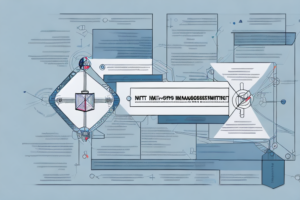What is security control lifecycle in RMF?
7 min read
A cycle with arrows and boxes to represent the stages of the risk management framework security control lifecycle
In this article we will explore a critical aspect of cybersecurity – security control lifecycle in RMF. RMF stands for Risk Management Framework. It is a crucial component of the overall cybersecurity strategy of an organization. Security control lifecycle in RMF is a continuous process that involves planning, implementation, assessment, authorization, and continuous monitoring of security controls. In this article, we will dive deep into every aspect of the security control lifecycle in RMF.
Understanding the basics of RMF
Before we dive into the security control lifecycle in RMF, let’s briefly review what RMF is. RMF is a risk-based approach to security that provides a structured methodology for managing cybersecurity risk. It is a key component of the National Institute of Standards and Technology (NIST) Special Publication 800-37. RMF helps organizations to organize their cybersecurity efforts in a structured and methodical manner and to make informed risk management decisions.
One of the key benefits of using RMF is that it allows organizations to tailor their security controls to their specific needs and risk profile. This means that organizations can prioritize their security efforts and allocate resources more effectively. Additionally, RMF provides a framework for continuous monitoring and improvement, ensuring that security controls remain effective over time and that new risks are identified and addressed in a timely manner.
The importance of security control lifecycle in RMF
Security control lifecycle in RMF is a critical component of the overall cybersecurity strategy of an organization. It provides a structured approach to implementing, assessing, and continuously monitoring security controls. The security control lifecycle ensures that appropriate security measures are in place to protect an organization’s critical assets and to mitigate risks. The security control lifecycle is also essential for compliance with regulatory requirements.
One of the key benefits of the security control lifecycle is that it allows organizations to identify and prioritize their security risks. By conducting a thorough risk assessment, organizations can determine which security controls are most critical to their operations and allocate resources accordingly. This helps to ensure that security efforts are focused on the areas that are most vulnerable to attack.
Another important aspect of the security control lifecycle is that it provides a framework for continuous improvement. By regularly assessing and updating security controls, organizations can stay ahead of emerging threats and ensure that their security posture remains strong over time. This is particularly important in today’s rapidly evolving threat landscape, where new vulnerabilities and attack vectors are constantly emerging.
Key components of security control lifecycle in RMF
There are four key components of the security control lifecycle in RMF – Plan, Implement, Assess, and Authorize. These components are iterative, and the process is continuous. The key components are as follows:
Plan:
The Planning phase is the first step in the security control lifecycle in RMF. In this phase, the organization identifies the system boundaries, the critical assets, and the potential risks. Once the organization has identified the risks, it creates a plan to implement appropriate security controls to mitigate those risks.
Implement:
The Implementation phase is the second step in the security control lifecycle in RMF. In this phase, the organization implements the security controls identified in the Planning phase. The Implementation phase involves configuring systems, deploying security devices, installing software, and testing the controls.
Assess:
The Assessment phase is the third step in the security control lifecycle in RMF. In this phase, the organization assesses the effectiveness of the security controls that have been implemented. The Assessment phase involves testing and evaluating the security controls to ensure that they meet the organization’s requirements.
Authorize:
The Authorization phase is the final step in the security control lifecycle in RMF. In this phase, the organization evaluates the results of the Assessment phase and determines whether the system is ready for operation. If the system meets the security requirements, it is authorized for operation.
Continuous Monitoring:
Continuous Monitoring is an important aspect of the security control lifecycle in RMF. It involves ongoing monitoring of the system to ensure that the security controls are working effectively and that the system is secure. Continuous Monitoring helps to identify any new risks or vulnerabilities that may arise and allows the organization to take appropriate action to mitigate those risks.
Documentation:
Documentation is another important component of the security control lifecycle in RMF. It involves documenting all aspects of the security control process, including the planning, implementation, assessment, and authorization phases. Documentation helps to ensure that the security controls are implemented consistently and that the system is secure. It also helps to provide a record of the security control process, which can be used for auditing and compliance purposes.
Different phases of security control lifecycle in RMF
As mentioned earlier, the security control lifecycle in RMF consists of four phases – Plan, Implement, Assess, and Authorize. Let’s take a closer look at each phase.
Planning phase of security control lifecycle in RMF
The Planning phase is the first phase of the security control lifecycle in RMF. During this phase, the organization identifies the system boundaries, critical assets, and potential risks. The organization also develops a plan to implement security controls to mitigate the identified risks.
Implementation phase of security control lifecycle in RMF
The Implementation phase is the second phase of the security control lifecycle in RMF. During this phase, the organization implements the security controls identified in the Planning phase. The Implementation phase involves configuring systems, deploying security devices, installing software, and testing the controls.
Assessment phase of security control lifecycle in RMF
The Assessment phase is the third phase of the security control lifecycle in RMF. During this phase, the organization assesses the effectiveness of the security controls that have been implemented. The Assessment phase involves testing and evaluating the controls to ensure that they meet the organization’s requirements.
Authorization phase of security control lifecycle in RMF
The Authorization phase is the final phase of the security control lifecycle in RMF. During this phase, the organization evaluates the results of the Assessment phase and determines whether the system is ready for operation. If the system meets the security requirements, it is authorized for operation.
Continuous monitoring phase of security control lifecycle in RMF
The Continuous Monitoring phase is a critical aspect of the security control lifecycle in RMF. In this phase, the organization continuously monitors the effectiveness of the security controls that have been implemented. The Continuous Monitoring phase involves ongoing testing and evaluating of the security controls and making necessary adjustments to ensure that they are effective. The Continuous Monitoring phase ensures that the organization is vigilant and always aware of any changes to the security posture of their systems.
Common challenges faced during the implementation of security control lifecycle in RMF
The implementation of the security control lifecycle in RMF can be a challenging process. Common challenges include lack of resources, inadequate training, and limited support from senior management. It is also challenging to keep up with the ever-changing threat landscape and to ensure that the security controls are always effective.
Best practices for effective implementation of security control lifecycle in RMF
To ensure the effective implementation of the security control lifecycle in RMF, organizations can follow some best practices. Some of these best practices include involving all stakeholders, establishing a risk management culture, developing a robust security policy, and providing adequate training to security personnel. Organizations should also adopt a risk-based approach to security and stay current on emerging threats and risk mitigation strategies.
How to ensure compliance with regulatory requirements while implementing security control lifecycle in RMF
Compliance with regulatory requirements is critical when implementing the security control lifecycle in RMF. To ensure compliance, organizations should identify the regulatory requirements applicable to their systems and create a plan to implement the necessary security controls to meet those requirements. Organizations should also ensure that their security policy and procedures meet the regulatory requirements and that they are regularly updated to reflect any changes in the regulations.
Integrating risk management into security control lifecycle in RMF
Risk management is an essential aspect of cybersecurity, and it is important to integrate risk management into the security control lifecycle in RMF. Organizations should adopt a risk-based approach to security and consider the potential risks of their systems when implementing security controls. Organizations should also regularly evaluate the effectiveness of the security controls and make necessary adjustments to ensure that they remain effective.
The future of security control lifecycle in RMF and its impact on cybersecurity
The cybersecurity landscape is constantly evolving, and there is a need for continuous improvement in the security control lifecycle in RMF. Emerging technologies such as Artificial Intelligence (AI) and Internet of Things (IoT) are presenting new challenges to cybersecurity and require organizations to adopt new risk mitigation strategies. The future of the security control lifecycle in RMF is likely to see increased emphasis on risk-based decision making and the integration of emerging technologies into the cybersecurity framework.
Conclusion
In this article, we have explored the critical aspect of cybersecurity – security control lifecycle in RMF. We have looked at the key components of the security control lifecycle and the different phases involved. We have also discussed the challenges faced during the implementation of security control lifecycle in RMF, and the best practices for effective implementation. Compliance with regulatory requirements is essential, and we have discussed the strategies to ensure compliance. Finally, we have looked at the future of security control lifecycle in RMF and its impact on cybersecurity.



